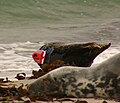Animal identification

Animal identification using a means of marking is a process done to identify and track specific animals. It is done for a variety of reasons including verification of ownership, biosecurity control, and tracking for research or agricultural purposes.
History[]
Individual identification of animals by means of body markings has been practiced for over 3,800 years, as stated in Code of Hammurabi.[1] The first official identification systems are documented as far as the 18th century. In Uruguay for instance maintained at that time a register of hot brands.[2]
Methods[]
Birds[]
- Leg rings
- Wing tags
- Microchip implants (parrots)
- Telemetry (falconry birds)
Sheep[]
- Freeze branding
- Branding (hot-iron)
- Collar
- Earmarking
- Ear tags (non-electronic)
- Ear tags (electronic)
- Semi-permanent paint
Pigs[]
- Collars (electronic and non-electronic)
- Earmarking
- Ear tags (non-electronic)
- Ear tags (electronic)
- Semi-permanent paint
- Tattoo
Horses[]
- Collars (non-electronic)
- Branding (hot-iron)
- Branding (freeze)
- Microchip implants
- Lip tattoo
Cattle[]
- Anklets
- Branding (freeze)
- Branding (hot-iron)
- Collars (electronic and non-electronic)
- Earmarking
- Ear tags (non-electronic)
- Ear tags (electronic)
- Rumen bolus (electronic)
- Cowbell
Dogs[]
- Collar
- Microchip implants
- Tattoo
Laboratory mice[]
- Earmarking (notching or punching)
- Ear tags (nickel, copper or scannable 2D barcode tags)
- Microchip implants
- Hair dye
- Toe clipping[note 1]
- Manual tattoos (tail, foot pad or ears)
- Automated tail tattoos[3]
Fish[]
- Microchip implants
- Fin clipping
- Coded wire tag
- Passive integrated transponder
- Acoustic tag
- Visible implant elastomer (VIE)
Marine mammals[]
- Transponders
- Adhesive tags
Amphibians[]
- Microchip implants
- Toe clippings
- Passive integrated transponder
- Visible implant elastomer (VIE)[4]
Invertebrates[]
- Adhesive tags
- Semi-permanent paint
National animal identification schemes[]
- British Cattle Movement Service in Britain
- National Animal Identification and Tracing in New Zealand
- National Animal Identification System in the United States
- National Livestock Identification System in Australia
Footnotes[]
- ^ 'Toe clipping' in mice involves the full or partial amputation of one or more digits as a means of permanent identification.
Gallery[]
Great frigatebird with a wing tag

Bird ring

Sheep with an earmark

Pig with earmark

Horse with a brand

Santa Gertudis cattle with electronic and non-electronic ear tags

Calf with a non-electronic ear tag, numbered collar and transponder (blue device)

Bear with an ear tag and transponder

Tattoo inside a Greyhound's ear

Dog collar with dog license and other dog tags

A microchip implant and applicator

A laboratory mouse with an ear tag

Fish with a transponder

Harbour seal with a transponder

Common seal with an adhesive tag

European queen honey bee marked with a paint spot surrounded by Africanised honeybees

Sheep with painted number

Monarch butterfly tagged with a sticker

Mussels being tagged
References[]
- ^ Blancou, J (2001). "A history of the traceability of animals and animal products". Revue Scientifique et Technique (International Office of Epizootics). 20 (2): 413–25. PMID 11548516.
- ^ "Allflex Corporate Web Site - the history of livestock identification".
- ^ Bell, J. "Labstamp system" (PDF). Archived from the original (PDF) on February 26, 2015. Retrieved February 26, 2015.
- ^ Fouilloux, Chloe; Garcia-Costoya, Guillermo; Rojas, Bibiana (2020). "Visible Implant Elastomer (VIE) Success in Early Larval Stages of a Tropical Amphibian Species". PeerJ. 8: e9630. doi:10.7717/peerj.9630. PMC 7425637. PMID 32864207.
| Wikimedia Commons has media related to Animal identification. |
- Animal identification
- Ethology

















